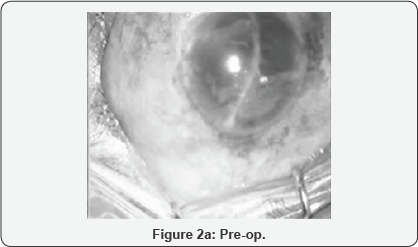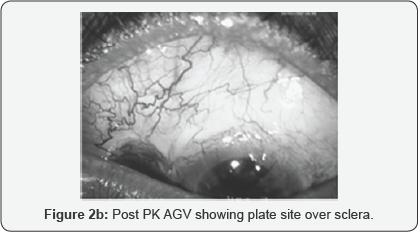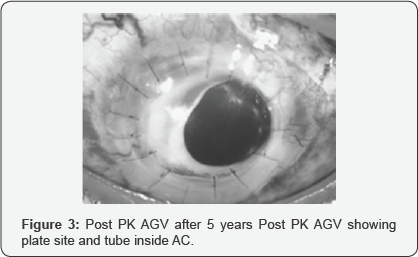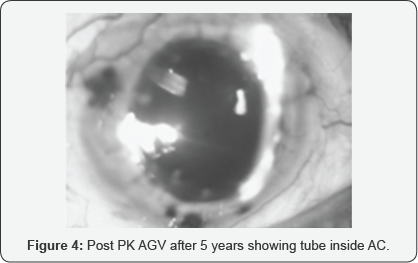JUNIPER
PUBLISHERS- JOJ Ophthalmology
Introduction
Glaucoma after penetrating keratoplasty (PK) is an
important cause of graft failure besides loss of vision due to
glaucomatous optic atrophy. Causes of post PK glaucoma are
multifactorial [1]
such as increased post-op inflammation due to
synechiolysis/pupillopasty, combined with cataract extraction and or
vitrectomy, retained viscoelastic, tight suturing causing tissue
compression, large graft size, long suture bites, peripheral anterior
synechiae and prolonged use of steroids. Management includes medical
therapy and in refractory cases surgical interve. The present study aims
to describe long-term outcomes of Ahmed Glaucoma Valve (AGV)
implantation in Post Keratoplasty glaucoma performed at a Tertiary Eye
Centre.
All subjects with Post PK Glaucoma who had undergone
AGV implantation with a follow-up of minimum 5 years were evaluated.
Preoperative antiglaucoma medication continued postoperatively and
titrated according to the need. Surgical steps followed same in all
except plate was covered either by conjunctiva or by scleral patch.
Before starting the surgery, priming of the tube was done (Figure 1).
After entering AC the tube was inserted and cut at desired length and
the plate was covered. Clinical photographs were taken at different time
period of time (Figure 2-4).





Of 32 eyes, the IOP decreased from a mean
preoperative value of 32.8±3.6mmHg to 20.0±8.6mmHg at last visit. The
number of medications decreased from 3.2±0.8 preoperatively to 2.2±1.2
postoperatively. Cumulative qualified success was achieved in 72% of
eyes. The common complication was focal endothelial corneal
decompensation at the site of tube-cornea touch.
Discussion
Management of Post PK glaucoma includes topical antiglaucoma medications and surgical options [1-3].
Medical management alone is not sufficient to control the Pressure
besides its own hazards such as corneal decompensation, dry eye, CME in
aphakic, psedophakic eyes, and recurrence of herpetic infection and
depression. A result of Trabeculectomy in such eyes often fails. The
valve helps to minimize postoperative hypotony and its associated
complications.
Conclusion
AGV implantation with adjunctive topical anti-glaucoma drops controlled IOP in approximately 72% of eyes with Post PK glaucoma.
For more articles in JOJ Ophthalmology (JOJO) please click on: https://juniperpublishers.com/jojo/index.php
No comments:
Post a Comment